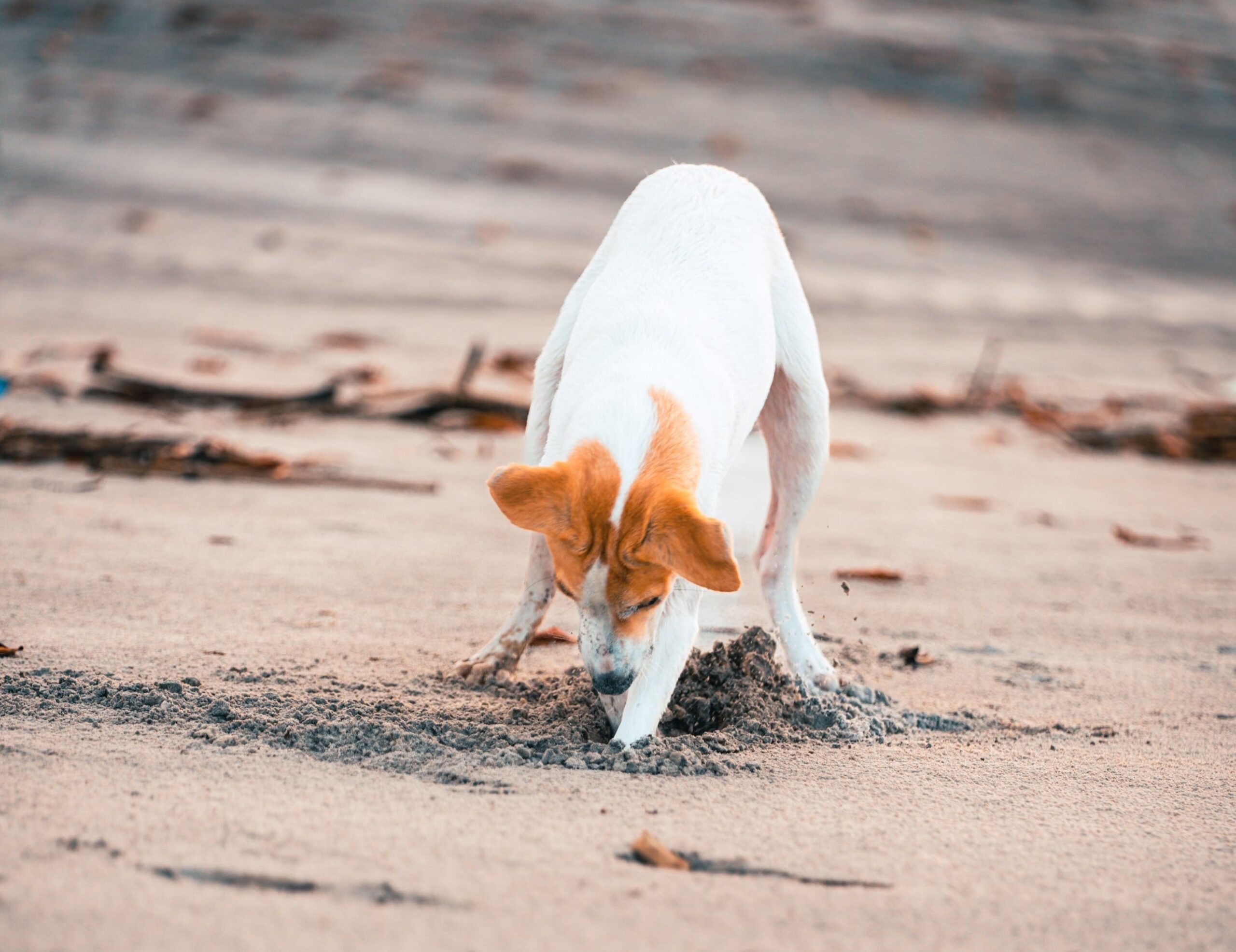Dealing with a dog’s penchant for digging under the fence can be a common challenge for pet owners.
If you’ve found yourself frustrated by your furry friend’s escape artist tendencies, you’re not alone.
In this guide, we’ll explore practical strategies and expert tips on how to stop dogs from digging under the fence.
From understanding the reasons behind this behavior to implementing effective deterrents, let’s embark on a journey to secure your yard and keep your canine companion safely within bounds.
Table of Contents
Digging Dilemma: How to Stop Dogs From Digging Under the Fence?

1] Understand Your Dog’s Motivations: Unraveling the Mystery of Digging
Delve into the intricacies of your dog’s digging habits by understanding the motivations behind this behavior.
Dogs may dig for various reasons, including boredom, a desire to escape, or even as an instinctual behavior.
Observing when and where they dig can provide valuable clues.
Identifying the root cause is essential for implementing targeted solutions, whether it’s addressing boredom through increased stimulation or enhancing the security of your dog’s environment.
2] Create a Designated Digging Area: Channeling Instincts Positively
Providing an outlet for your dog’s innate digging instincts involves creating a designated digging area in your yard.
Choose an accessible spot with soft soil, making it an enticing space for your dog to indulge in their natural behavior.
Bury toys or treats in this area to encourage digging specifically in that location.
This not only redirects their instinctual behavior but also preserves other areas of your yard from unwanted excavation.
3] Bury Chicken Wire: Adding a Physical Deterrent
Enhance your fencing strategy by burying chicken wire along the fence line.
This physical deterrent serves as an obstacle for your dog, making digging along the perimeter less appealing.
Ensure the wire is securely buried to avoid any safety concerns.
The uncomfortable texture of the wire discourages digging, reinforcing the boundaries you’ve established to keep your dog safely within the yard.
4] Apply Digging Deterrents: Unpleasant Sensations for Paws
Explore the world of commercial digging deterrent products designed to create unpleasant sensations for your dog’s paws.
These products often utilize scents or textures that dogs find disagreeable.
Following the provided instructions is crucial for safe and effective application.
These deterrents act as a gentle yet effective reminder, dissuading your dog from continuing their digging endeavors.
Digging deterrents can be a valuable tool in your toolbox, but consistent supervision and positive reinforcement are key components of successful training
5] Increase Physical and Mental Stimulation: A Tired Dog is a Happy Dog
Recognizing that a tired dog is a content dog, focus on increasing both physical and mental stimulation in your dog’s daily routine.
Regular walks, interactive play sessions, and engaging puzzle toys are excellent ways to fulfill these needs.
A well-exercised and mentally stimulated dog is less likely to resort to digging out of boredom or excess energy, contributing to a more balanced and satisfied canine companion.
6] Apply Strong Scents as Repellents: Nurturing a Sensitive Nose
Leverage your dog’s sensitive nose by applying strong-smelling substances around the base of the fence.
Citrus peels, vinegar, or commercial pet repellents can act as natural deterrents.
These scents create a barrier, signaling to your dog that the area is off-limits for digging.
This method nurtures their sensitive olfactory senses while establishing a clear boundary.
7] Install an L-Footer: A Barrier to Deter Digging
Reinforce your fencing strategy by attaching an L-shaped footer along the bottom of the fence, extending outward.
This physical barrier adds an extra layer of difficulty for dogs attempting to dig underneath.
The L-Footer acts as a visual and tangible deterrent, making digging along the fence line a challenging endeavor.
It reinforces the boundary, promoting a secure and well-defined space for your dog.
8] Provide Adequate Exercise: Drain Excess Energy
Emphasize the importance of regular exercise to prevent boredom-driven digging.
Dogs with excess energy are more prone to engaging in destructive behaviors.
Ensure your dog receives enough physical activity through walks, playtime, and mentally stimulating activities.
A well-exercised dog is not only healthier but also less likely to resort to digging as a means of alleviating restlessness.
• Emphasize regular exercise to prevent boredom-driven digging • Excess energy can lead to destructive behaviors • Ensure physical activity through walks, playtime, and mental stimulation • A well-exercised dog is healthier and less likely to dig out of restlessness
9] Utilize Pet-Friendly Repellents: Safe Solutions to Discourage Digging
Explore the realm of pet-friendly repellents designed to deter dogs from specific areas.
These safe solutions often incorporate scents or tastes that dogs find unappealing.
By using pet-friendly options, you ensure that the deterrents are effective without causing harm to your dog.
These products act as gentle reminders, encouraging your dog to avoid certain areas without compromising their well-being.
10] Use Boulders or Rocks: Natural Obstacles for Digging Prevention
Enhance your landscaping strategy by strategically placing large rocks or boulders along the fence line.
Dogs are less likely to dig in areas with obstacles, making this a natural and visually appealing solution.
Not only does it discourage digging, but it also adds an aesthetic element to your yard, creating an environment that is both functional and visually pleasing.
11] Train with Positive Reinforcement: Reward Desired Behavior
Incorporate positive reinforcement into your training approach by rewarding your dog for displaying desired behavior, such as refraining from digging.
Treats, praise, or affection serve as positive rewards, creating a strong association between not digging and receiving positive outcomes.
This method encourages your dog to make the connection, fostering a harmonious relationship based on positive reinforcement.
12] Consider Planting Thorny Shrubs: Natural Deterrents
Integrate natural deterrents into your landscaping strategy by planting thorny shrubs or bushes along the fence line.
The presence of prickly vegetation acts as a natural deterrent, dissuading dogs from digging in those areas.
This not only adds a layer of protection to your yard but also contributes to the overall aesthetics of your landscaping.
Dogs’ lives are too short. Their only fault, really.
– Agnes Sligh Turnbull (author, The Wedding Bargain)
13] Supervise Outdoor Time: Intervene When Necessary
Maintain a hands-on approach by closely supervising your dog during outdoor time.
If you catch them in the act of digging in undesired areas, intervene with a firm “no” and redirect their attention to the designated digging area.
Consistent supervision ensures timely corrections and reinforces the boundaries you’ve established, guiding your dog toward appropriate digging behavior.
14] Provide Shelter and Shade: Comfortable Outdoor Spaces
Acknowledge your dog’s natural instincts by ensuring your yard has shaded and comfortable areas.
Dogs may dig to create a cool spot or find shelter.
Providing alternative comfortable spaces, such as a dog house or shaded lounging area, reduces the need for digging.
This approach caters to your dog’s natural inclinations while minimizing the impact on your yard.
• Acknowledge dog's instincts with shaded areas • Dogs may dig for a cool spot or shelter • Provide alternative comfortable spaces like a dog house • Cater to natural inclinations, minimize yard impact
15] Consult a Professional: Seeking Expert Advice
Recognize the value of seeking expert advice if your efforts prove challenging.
Consulting a professional dog trainer or behaviorist allows for a thorough assessment of the specific factors contributing to your dog’s digging behavior.
Their expertise can uncover nuances that may not be apparent, leading to personalized and effective solutions tailored to your dog’s unique needs.
How to Stop Dogs From Digging Under the Fence: FAQs
Can digging be a sign of health issues?
Yes, excessive digging can be a sign of underlying health issues. If your dog’s digging behavior is unusual or accompanied by other concerning signs, consult with a veterinarian for a health check.
Are certain breeds more prone to digging?
Certain breeds, particularly those with digging instincts, may be more prone to digging. Breeds like terriers, dachshunds, and beagles may require additional training and stimulation.
How deep should the chicken wire be buried for effectiveness?
Bury the chicken wire at least 1 to 2 feet deep along the fence line for optimal effectiveness. This depth makes it challenging for dogs to dig underneath and reinforces the barrier.
Can you use a shock collar to deter digging?
Using a shock collar for digging is not recommended, as it can cause fear and anxiety in dogs. Positive reinforcement and humane deterrents are preferable for addressing digging behavior.
What if my dog continues to dig despite efforts?
If your dog continues to dig despite your efforts, consider seeking professional advice from a dog trainer or behaviorist. They can provide personalized strategies based on your dog’s unique behavior and needs.

Conclusion:
Addressing your dog’s tendency to dig under the fence requires a combination of understanding, creativity, and consistent training.
By following these practical solutions on “How to Stop Dogs From Digging Under the Fence,” you’ll create a secure and enjoyable outdoor space for both you and your furry friend.
Remember, consistency is crucial, and adapting these strategies to your specific circumstances will enhance their effectiveness.
With a combination of patience, understanding, and proactive measures, you can successfully curtail your dog’s digging instincts and ensure a safer and more contained outdoor space for your beloved pet.





